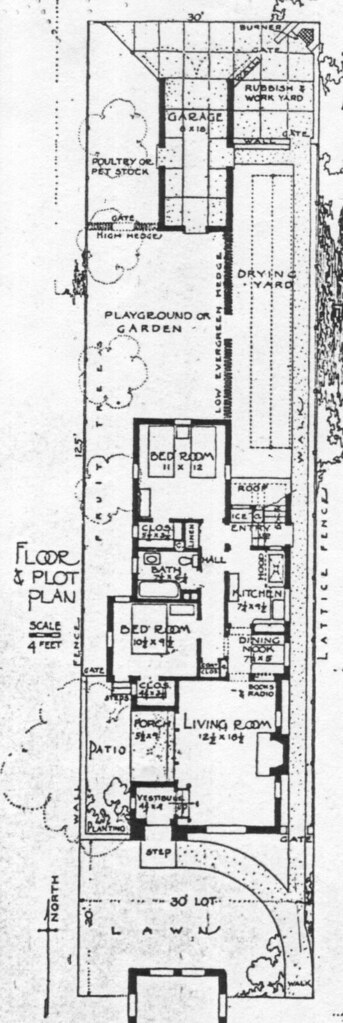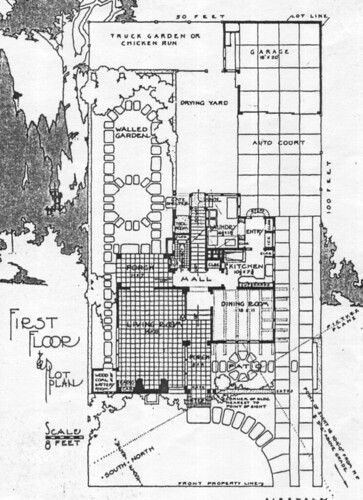As I am mocking up the site now, simply to serve as a background for exterior images of the house, I turn to some inspirations for suburban site planning that I think are still very relevant today.
Many years ago when I was still an architecture student I did a self-defined design studio project for designing a suburban subdivision. You have to realize how out of step that was with studying architecture. The suburbia, particularly residential suburbia was an architectural desert. Yet I took a semester to study how we carried out suburban development and the way we made houses, and suburban infrastructure. It was 1984 and most of my naive work as a student predated the New Urbanism movement. My project book is probably still on the library shelf in the architecture school library at Rensselaer Polytechnic Institute. Go look it up if you are curious.
Anyhow back then I dug into a few dozen "pattern books" - that would be catalogs of stock plans - from the library published in the 1940s. Just like today they were full of current as well as reasonable recent designs - things from the 30's and 40's. I was taken with the way they presented the houses, usually with all the plans and elevations presented on one tidy letter size page. Often the ground floor of the house was presented with a rendered site plan - hypothetical - but significant as it demonstrated how the house could be integrated into the site. In a word the site plans were wonderful. These were different days and suburban lots were much smaller than normal today, and the middle class expectation was smaller as well. Yet these siteplans presented a rich and functional environment for these house plans. I had copied some of my favorites from those books all those years ago, and this morning I dug them out of the file in my basement as they were on my mind as I worked up my site plan model. Lets look at them:

The first comes from a house plan simply titled Design for a Six Room House. How great is that! It is a 3 bedroom house. The first thing I should point out is the size of the lot is 35ft wide, and 125 ft deep. That is a small lot, unheard of today. The house has a front loaded garage, unusual for that time, but its near impossible to pass the house to a garage out back. So what do we have brewing in the yard? About half of the yard is dedicated to a Walled Garden. This garden is off the living room and is shown with some stone paving. This would be the extend of the pleasant outdoor living space. Directly behind it is a smaller yard, divided by the garden wall called a Playground Truck Garden or Poultry Run. Dig that - either a small yard for the kids to crash around in, or someplace for your chickens! Very practical. The other half of the yard is taken up by a long space simply called a Drying Yard. Two long clothes lines are shown with a paved walk between them. Again, how practical that you would dedicate nearly half your outdoor space to productive outdoor uses. I won't go on right now about the vilification of clothes lines in suburban America - its been looked down on as lower class and this is a grievous injustice. We all need to save energy, and experience the joy of fresh line dried items. Behind the drying yard is a small space set aside for rubbish and yard work implements - and horrors - a home incinerator! We actually have a relic of one of those in our own yard! All in all I love the purposefulness of these structured yards, and the way they serve the home - not as a burden to maintain, but as a working part of the household. The front yard is very small by comparison - just enough for some street appeal because after all that land has a job to do.

The next is called Design for a Five Room House - surprise! This time on a 30ft wide lot, again 125ft deep. But this design benefits from an alleyway with rear access to a detached garage. Again we have a main garden space, this time shared with play space. Behind it is a poultry or dog run. Yes, not that long ago many of us kept chickens! The other side is again dedicated to a drying yard, and a rubbish and work space behind it. So useful, so civil, so well considered. What has happened to us? A home bought today comes with graded dirt in the yard, if you don't spring for the extra sod. We have certainly lost our way here - all that land to tax your time, to maintain, but never giving anything back. And we all know that it so wants to! Chickens, or a small vegetable garden, enough lines to really dry all your laundry, a discrete place for tools and trash, and a limited area to enjoy as well as a limited area to manicure.

The last is a more familiar proportion lot at 50ft wide by 100ft deep. Nearly the same as our contest house presumed lot. Here they manage to pass the driveway by the house - much more willing to squeeze the driveway against the house than we seem to be today. In the back the drive widens to an Auto Court serving a two car garage at the back of the lot. Again we have a walled garden, a drying lawn, and a playground truck garden or chicken run. The front yard is very small, and the rear yard is maximized.
I think the practices we see in these old site plans suit our sustainably trending present. Living in the suburbs is a luxury, and a luxury that we can begin to pay for by using the given land to reduce our load on the world in other ways. Line drying clothes is a no-brainer. Composting kitchen scraps, and yard waste to use in the gardens, chickens sure, but perhaps a small vegetable garden will come in less conflict with regressive zoning regulations. A working space in the yard for trash and work bench and yard tools - and DIY projects. We can do this people. Its not some horrible sacrifice to live more sustainably. It is an incredibly rich, rewarding, and satisfying choice. And it comes with a backyard that Rocks!
Tidak ada komentar:
Posting Komentar